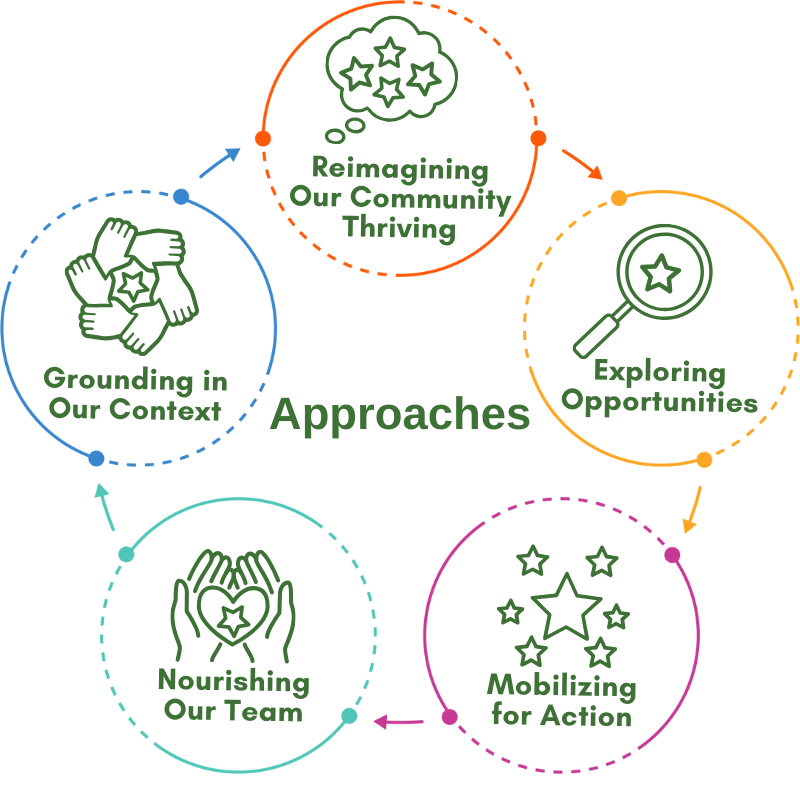Approaches to Support Your Congregation
As your team goes through the Green Sanctuary 2030 Process, you’ll have resources and activities to help you:
Develop and nourish your team
Ground your actions in the realities of oppression and harm in your community
Create a shared reimagining of your community thriving
Explore possible actions for each Essential
Agree on short-term actions and long-term goals
You can work through each approach or focus on the ones that are most useful for your team. Do what works! For each Approach, the UUA designed a 90-minute session to guide your team through the process. The sessions are designed to spark connection and conversation and open the way for deeper explorations. Each session is organized in the same way with text that participants can read aloud and timing information for each part of the meeting. If you would rather not use the sample agendas, you can reflect on the Questions for Exploration in whatever way works best for your team.
Nourishing Our Team
Creating, nourishing, and sustaining your team is an important and ongoing process. Mapping out your people to strategize how you prioritize recruitment, relationships and leadership development ensures a nourishing team culture, cohesion, and shared leadership.
Map our people (aka, our Base)
Explore team culture and how to nourish and strengthen your team
Grounding in Our Context
Understanding how different injustices are connected helps us more effectively identify the specific conditions you want to change. Together, you will explore the historical and current realities of oppression in your area, and how those challenges will shape your Green Sanctuary Goals and Actions.
Identify and map out the Challenging Realities in your community
Deepen your understanding of how oppression historically and currently harms members of your community in different ways
Reimagining Our Community Thriving
We must challenge ourselves to not just imagine baseline survival, but also a flourishing, nourishing, and joyful future where everyone thrives. Together, you will identify Faithful Commitments that will guide our shared work.
Draw both individual and collective “Rich Pictures” to ground ourselves in what you imagine as the Beloved Community
Adopt a “2050 Thriving Community Promise” that serves as a faithful reminder to continue a practice of imagining our community thriving.
Mobilizing for Action
Drawing on your exploration of opportunities, work together to agree on long-term goals and short-term actions that build toward a thriving community.
Five Year Goals
Review the 2050 Thriving Community Promise you created in Reimagining Our Community Thriving
Adopt Goals to achieve within the next five years that work towards your Promise
This Year’s Actions
Agree on Actions to work on this year
Exploring the Possibilities for the Four Essentials
Collaboratively reflect on each Essential for Climate Action and brainstorm possible actions for this year and within the next five years.
Congregational Transformation
Working together to improve the ways we organize and collaborate
Draft a systems map to understand your congregation better while identifying opportunities for collaboration
Explore questions that will inform your possible actions for Congregational Transformation
Brainstorm possible actions for this year and Five-Year Goals for Congregational Transformation
Community Resilience
Preparing for and responding to climate disruption while cultivating community care
Use a spiral scan to identify the people and ecosystems in your community that are most at risk of climate disruption
Explore questions that will inform your possible actions for our Community Resilience Essential
Brainstorm possible actions for this year and Five-Year Goals for Community Resilience
Justice
How we honor the inherent worthiness and right for all to flourish
Draft a Community Care map to identify ways to faithfully respond to the challenges in your community
Explore questions that will inform your understanding of the Justice Essential
Brainstorm possible actions for this year and Five-Year Goals for Justice
Mitigation
How we reduce the pollution that causes climate change
Engage in the future mapping process to ground your ideas for future work in past and present actions
Explore questions to help you better understand Mitigation
Brainstorm possible actions for this year and Five-Year Goals for Mitigation
Team Accountability Check-In
As your team works through each Essential, you will determine if your team is Learning, Resourcing, Building Relationships, Collaborating, Acting, and/or Reflecting. These categories are interdependent. One is not better or more important than the other.
Using the Team Accountability Check-In, mark an “X” in the appropriate category or categories (ex. Learning, Resourcing) for each Essential. Select as many categories per Essential as you feel are appropriate. There is also a space to indicate that you need feedback, guidance, or support. Your congregation will update your Team Report with this Check-In.
The Team Accountability Check-In provides a structure for your congregation to easily track your work on each Essential over time. This reflection can help you note growth over time. For example, if your 2025 Team Accountability Check-In says you’re “Learning” about the Justice Essential, and you need guidance or support, 2026 says “Building Relationships,” 2027 says “Collaborating,” and 2028 says “Resourcing” and “Acting,” that’s a pretty good indication that your team is progressing towards your goals. On the other hand, if your Team Accountability Check-In reflects Learning for 2025, 2026, 2027, 2028, etc., it’s probably a sign that you may need feedback, guidance, or support to move toward action.


